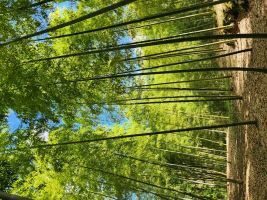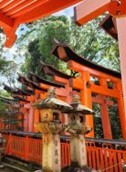Longtime UNS Member, Sharon Meyers, is currently living in Japan for several months. This is a glimpse into her world and journey.
Sit still, sit within
Sit with me and notice
Silence, nature’s sound
Listen. What do you hear? – cars, construction, perhaps even your phone? Kyoto is a remarkably quiet city considering its one million plus population, while chronic manmade noise is considered stressful. Sought by city dwellers, the “sound of silence” is the sound and space that only nature provides.
This week I took a half day trek to the iconic Fushimi Inari – a stepped pathway through 1,000 Torii gates, each a prayer of thanksgiving, up to the mountain top, then back down a less worn path of bamboo forest. Just a 25 minute train ride from Kyoto’s city center, this sacred Shinto sanctuary is a world away from urban life. The most sublime experience of nature’s silence was not in the mindful transition between the secular and spiritual realm of each vermillion gate, but the open exploration of the forest expanse – a fine example of “the road less taken.”
Beyond the land, seeking the sound of silence in Japan extends to the sky, especially during autumn’s full moon, which was celebrated earlier this week here. Tsukimi/ moon viewing is a custom and celebration that dates back over one thousand years. It offers a cultural moment of evening silence when the moon is at its brightest and most beautiful. Traditionally and even now, Japanese people sail boats to appreciate the moon’s reflection on the surface of the water, then write poetry or paint imagery on scrolls to honor tsukimi.
In listening more closely to the environment, I am reminded to value the sound of silence of the natural world: the knocking of the bamboo as the wind passes through, the rush of cascading water, sweet birdsong and insect chirping.
When was the last time you heard nothing – that was not a manmade sound? Are we so afraid of silence that we need to fill it?
Arigato,
Sharon







